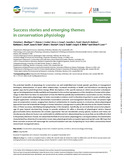| dc.contributor.author | Madliger, Christine L. | |
| dc.contributor.author | Cooke, Steven J. | |
| dc.contributor.author | Crespi, Erica J. | |
| dc.contributor.author | Funk, Jennifer L. | |
| dc.contributor.author | Hultine, Kevin R. | |
| dc.contributor.author | Hunt, Kathleen E. | |
| dc.contributor.author | Rohr, Jason R. | |
| dc.contributor.author | Sinclair, Brent J. | |
| dc.contributor.author | Suski, Cory D. | |
| dc.contributor.author | Willis, Craig K. R. | |
| dc.contributor.author | Love, Oliver P. | |
| dc.date.accessioned | 2016-12-09T23:17:08Z | |
| dc.date.available | 2016-12-09T23:17:08Z | |
| dc.date.issued | 2016 | |
| dc.identifier.citation | Madliger, C. L., S. J. Cooke, E. J. Crespi, J. L. Funk, K. R. Hultine, K. E. Hunt, J. R. Rohr, B. J. Sinclair, C. D. Suski, C. K. R. Willis, and O. P. Love. "Success stories and emerging themes in conservation physiology." Conserv Physiol 4(1) (2016): cov057. DOI:10.1093/conphys/cov057. | en_US |
| dc.identifier.issn | 2051-1434 | |
| dc.identifier.uri | http://hdl.handle.net/10680/1262 | |
| dc.description.abstract | The potential benefits of physiology for conservation are well established and include greater specificity of management techniques, determination of cause–effect relationships, increased sensitivity of health and disturbance monitoring and greater capacity for predicting future change. While descriptions of the specific avenues in which conservation and physiology can be integrated are readily available and important to the continuing expansion of the discipline of ‘conservation physiology’, to date there has been no assessment of how the field has specifically contributed to conservation success. However, the goal of conservation physiology is to foster conservation solutions and it is therefore important to assess whether physiological approaches contribute to downstream conservation outcomes and management decisions. Here, we present eight areas of conservation concern, ranging from chemical contamination to invasive species to ecotourism, where physiological approaches have led to beneficial changes in human behaviour, management or policy. We also discuss the shared characteristics of these successes, identifying emerging themes in the discipline. Specifically, we conclude that conservation physiology: (i) goes beyond documenting change to provide solutions; (ii) offers a diversity of physiological metrics beyond glucocorticoids (stress hormones); (iii) includes approaches that are transferable among species, locations and times; (iv) simultaneously allows for human use and benefits to wildlife; and (v) is characterized by successes that can be difficult to find in the primary literature. Overall, we submit that the field of conservation physiology has a strong foundation of achievements characterized by a diversity of conservation issues, taxa, physiological traits, ecosystem types and spatial scales. We hope that these concrete successes will encourage the continued evolution and use of physiological tools within conservation-based research and management plans. | en_US |
| dc.description.sponsorship | "This work was supported by the Society for Integrative and Comparative Biology; the University of Windsor, Ontario, Canada; Dalhousie University, Nova Scotia, Canada; and the Canadian Society of Zoologists. C.L.M. was supported by a Natural Sciences and Engineering Research Council of Canada PGS-D (427552). S.J.C. and O.P.L. are supported by the Canada Research Chairs program. E.J.C. was supported by a grant from the National Science Foundation (BCS-1134687). K.R.H. was supported by grants from the National Science Foundation’s MacroSystems Biology program (award no. 1340856) and the US Department of Agriculture (NRI 2015-67013-23138). J.R.R. was supported by grants from the National Science Foundation (EF-1241889), National Institutes of Health (R01GM109499, R01TW010286), US Department of Agriculture (NRI 2006-01370, 2009-35102-0543) and US Environmental Protection Agency (CAREER 83518801)." | en_US |
| dc.description.uri | https://academic.oup.com/conphys/article/4/1/cov057/2951293 | |
| dc.language.iso | en | en_US |
| dc.publisher | Oxford University Press and the Society for Experimental Biology | en_US |
| dc.rights | info:eu-repo/semantics/openAccess | |
| dc.subject | Conservation of natural resources | en_US |
| dc.title | Success stories and emerging themes in conservation physiology | en_US |
| dc.type | Article | en_US |
| dc.identifier.doi | 10.1093/conphys/cov057 | |

